This was published 5 years ago
Mekong River cruise: Seeing Cambodia and Vietnam by bike and boat
By Jamie Lafferty
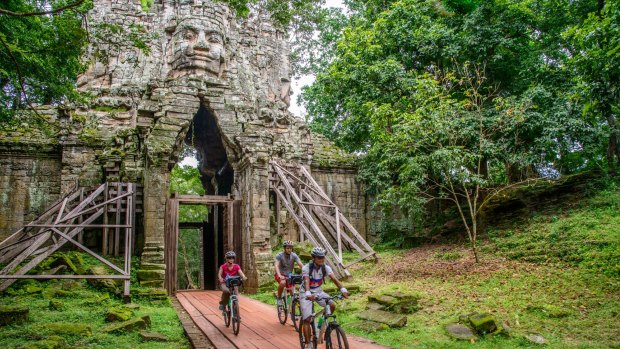
Cycling through Angkor Wat.
Even if I'd been blessed with good balance, which I wasn't, and lived somewhere that required a commute, which I don't, I suspect I would have always found cycling to be a very literal pain in the arse.
I had plenty of time to contemplate this in rural Vietnam and then Cambodia with Grasshopper Adventures as I repeatedly adjusted my position on what was a surely too-small bike seat. We were approximately following the course of the mighty Mekong, north from the Delta in southern Vietnam all the way to the colossal Tonle Sap lake in Cambodia. I had no doubts about the newness of the bike I'd been given by Grasshopper, but in the early days I did have doubts about cycling as an overall concept. Prior to coming on the company's first running of this new Mekong Bike and Boat tour, I had invested in padded shorts, and chamois cream, then finally ibuprofen, all in a bid to ease the suffering of my derriere.
If my fellow riders – all Australian, all old enough to be my parents – were in as much agony they did a better job of hiding it. Perhaps this should not have been a surprise. I have long known that senior Australians are flinty people, unlikely to cave under pressure but on the end of the first day of cycling, I unwisely decided to test this theory.
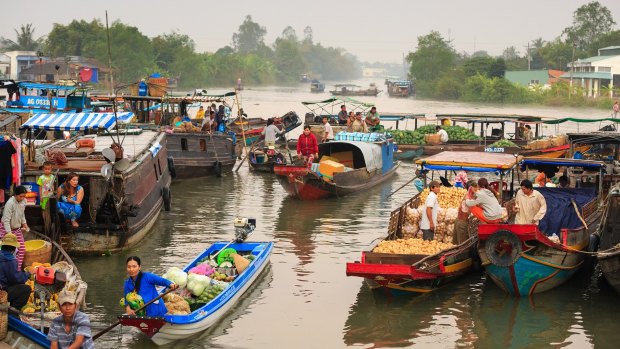
Life along the Mekong in Cambodia.
Our Vietnamese cycling guide, Thang Huynh, explained that the final two kilometres of the ride were in a straight line and that he was going to hang back to check on the more casual riders – we frontrunners could find our own way back to the little ferry that would take us back to our ship the Toum Tiou. I used this opportunity to fly away from the rest, tightening the gears and opening my leg muscles to remind the group of the power of youth. Quickly the noise of the countryside fell away and I felt alone. Imagine my surprise, then, when I heard 67-year-old Russ Bittner say, "car-up" warning me of a vehicle up ahead.
I redoubled my efforts and after a few minutes, or perhaps only seconds, I started not to think about the burning in my legs or the heaving of my lungs. All of that stripped away and what was left was a small, gnarled lump, like a walnut. Perhaps it was my sense of competition or determination, but so long as it didn't crack, I found that everything else could keep going. I arrived at the jetty a sweaty, sweary mess. Russ was only a couple of seconds behind.
This, of course, was not the idea for the trip. Grasshopper's concept is much more sedate: a chance for riders to experience life along the Mekong, to better understand rural life in Vietnam and Cambodia, before finally being bussed up to Siem Reap and the mighty Angkor Wat, the tour's terminus. At most we cycled 70 kilometres in a day, stopping often for food, fluids and impromptu lectures.
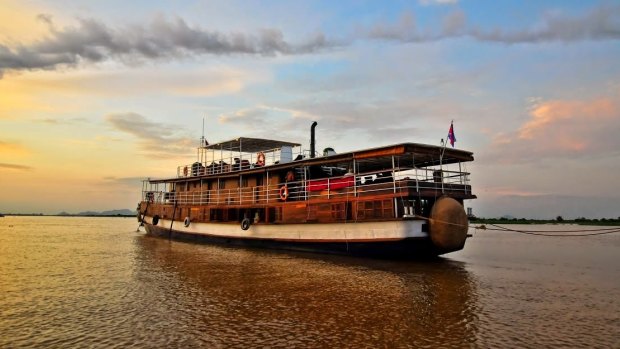
Sunset on the Mekong.
There were endless surprises. After a largely uneventful morning on our first day of cycling in Cambodia we arrived at the former Khmer capital, Oudong. When we parked the bikes next to a pagoda, someone noticed that behind its dirty glass, the thing was filled with skulls, a grim reminder of the Khmer Rouge's barbarism. We left this macabre monument for a short, stiff hike to the top of Phnom Oudong with 360-degree views stretching to the hazy horizon. As always seems to be the case with Cambodia, darkness was soon followed by light.
For some on the tour, riding was not a priority – not really a factor at all. This included Meredith Liddle. Along with husband Gary (who was riding) she is a founder of Children of Cambodia, a foundation formed in 2010 to improve schools within a 60-kilometre radius of Siem Reap. Towards the end of the tour, we visited two of its beneficiaries, Beoung and Chom Roeun Roth, and saw that its good work is having very real benefits for the area's children.
Prior to that, Meredith and other wheel-widows were provided private tours through the same neighbourhoods in which we cycled. Most days, we met out on the road where the staff had prepared water-and-fruit stations to give us all some respite from south-east Asia's bouncing humidity.
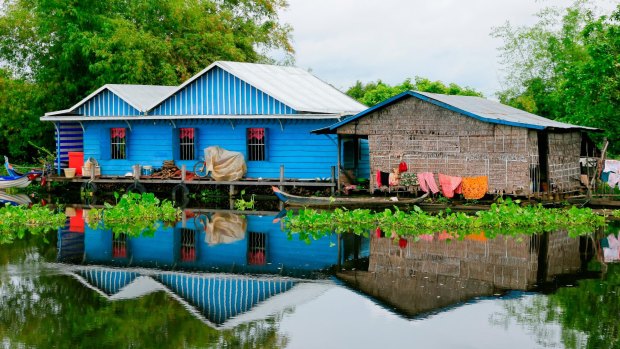
Water villages along Tonle Sap, the largest lake in Southeast Asia.Credit: Shutterstock
On our penultimate day in Vietnam, the narrow country lanes led us to cycle past a series of weddings. Thang later explained that they tend to be festive but brief affairs – most people go back to work the same afternoon. Karaoke also plays a part, even though most singers are woefully under-skilled, if ferociously committed. "Would you listen to that?" said Mick Ulbrick, one of my co-cyclists, to no one in particular, before accurately describing the singing as "in no way melodious".
If those banshee wails were off-putting, however, they were in stark contrast to the welcomes we received while cycling through most hamlets, villages, and towns. Grasshopper deliberately avoided any cycling in major cities, and most of the settlements through which we pedalled receive few tourists. This meant that we were inundated with choruses of "hello!" or by small regiments of children rushing to the road to offer slightly too enthusiastic high-fives.
Over the course of the 11 days, we were extraordinarily lucky with the weather. The tropical rains did come, but good planning and fortune meant we never got caught out too badly. Towards the end, enormous storm clouds angrily gathered on the horizon and we all thought we were done-for. In the end we made it back to the boat before the bruised sky burst completely, but that didn't stop us getting wet.
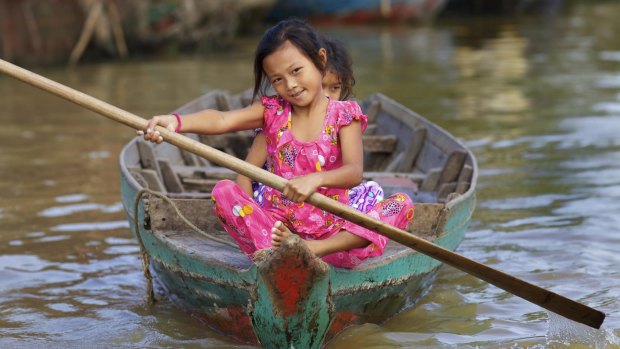
Children in a rowing boat on Tonle Sap Lake in Siem Reap, Cambodia.Credit: Shutterstock
A vent from a rice paddy, an outflow to release water back into the Mekong, blocked our path. Before we'd really had a chance to discuss tactics, Mick went for it, starting heroically before the cloying mud latched onto him half way and left him standing in thick, warm water. "I really thought I'd made it," said the 66-year-old, a little forlorn. "I really thought I had a chance." So did each of us. Kindly the staff on board the Toum Tiou dried our shoes for us overnight.
The majority of meals were eaten on the ship, with all of the lunches and dinners variations of Asian dishes. Some of the non-cyclists grumbled about how much there was (despite it being largely self-service) but those of us who had been out on the bikes greedily replaced our lost calories.
Aside from the fact that I actually do love cycling, if I learned anything during the trip it was that if there is a people flintier than the Australians, then it is surely the Vietnamese. On our last cycle together in Vietnam, Thang slowly started upping the pace for the peloton, getting faster and faster without warning. Wal Muir later described this as "Thang's hammer". Like the rest of us, he was exhausted when we finally came to a stop. It's tempting to say that Wal rides like a man half his age, but I am a man half his age and am neither as durable nor as skilled as the 70-year-old from Woolgoolga.
That night, as a fat sun sank over the Mekong and we had beers on the Toum Tiou's upper deck, I asked Thang about his merciless final flourish. He smirked: "Well I could see you were all pretty fit … You know, this tour is really about sight-seeing," his grin widened, "But sometimes you have to have a little fun."
FIVE SIGHTS ALONG THE MEKONG
No visit to Cambodia is complete without seeing the sensational Temples of Angkor, one of the world's very best archaeological sites.
Before leaving the Mekong Delta region, visit the floating markets. Cai Be is the closest to Ho Chi Minh City.
Phnom Penh is not one of Asia's loveliest capital cities, but visiting the harrowing Tuol Sleng Genocide Museum is vital to understanding the Khmer Rouge regime.
If you can't face Cambodia's grim past, the Royal Palace complex offers a well-managed and incredibly photogenic break from the wider city.
The mighty Tonle Sap is perhaps the most vital body of fresh water on the planet, with more people living off it than almost any other.
TRIP NOTES
Jamie Lafferty was a guest of Grasshopper Adventures
MORE
STAY
If you're tempted to spend extra time in Siem Reap, do so at the Jaya House River Park. This small hotel offers tuk tuks around town, massages and laundry, all included in the room price. Doubles from $300. See jayahouseriverparksiemreap.com
TOUR
The upstream tour starts in Ho Chi Minh City, Vietnam, and ends in Siem Reap, Cambodia. Grasshopper Adventures will resume its Mekong Bike and Boat tour next year with the option to travel downstream instead. Non-cyclists also welcome. Full board tours start from $6750, flights not included. See grasshopperadventures.com
Sign up for the Traveller Deals newsletter
Get exclusive travel deals delivered straight to your inbox. Sign up now.